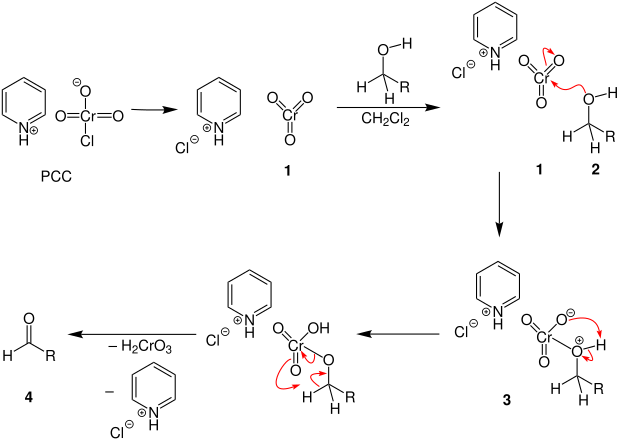Corey-Suggs oxidation
The Corey-Suggs oxidation (also PCC oxidation ), named after its discoverers EJ Corey and JW Suggs, is a name reaction from organic chemistry and was first published in 1975. The reaction describes the oxidation of a primary alcohol RCH 2 OH to an aldehyde . As oxidant is Corey's reagent , better known as pyridinium (short PCC) used:
The Corey-Suggs oxidation is similar to the Corey-Schmidt oxidation (PDC oxidation), it uses a similar but not identical oxidizing agent: pyridinium dichromate .
Overview reaction
A primary alcohol oxidizes to an aldehyde using dichloromethane and the oxidizing agent PCC:
Secondary alcohols R 2 CHOH can also be oxidized to ketones analogously .
Reaction mechanism
The mechanism is described in the literature:
A free electron pair of the primary alcohol 2 attacks the chromium (VI) oxide ( 1 ) chromium atom . The reactive intermediate stage 3 is thereby formed . Subsequent electron and atom rearrangement forms aldehyde 4 with elimination of hydrated chromium (IV) oxide, protonated pyridine and chloride .
Individual evidence
- ↑ GSC Srikanth Urlam Murali Krishna, Girish K. Trivedi and John F. Cannon: RCM / PCC oxidation strategy for synthesis of functionalized cyclic α, β-unsaturated lactones: synthesis of (+) - triacetoxygoniotriol and its diastereomers In: Bioorganic & Medicinal Chemistry Letters , 62 (48), 2006, pp. 11165-11171, doi: 10.1016 / j.tet.2006.09.016 .
- ^ EJ Corey and J. William Suggs: Pyridinium chlorochromate. An efficient reagent for oxidation of primary and secondary alcohols to carbonyl compounds In: Tetrahedron Letters , 16 (31), 1975, pp. 2647-2650, doi: 10.1016 / S0040-4039 (00) 75204-X .
- ↑ a b Z. Wang: Comprehensive organic name reactions and reagents Volume 1 . John Wiley, Hoboken (NJ) 2009, ISBN 978-0-470-28662-3 , pp. 742-745 .


